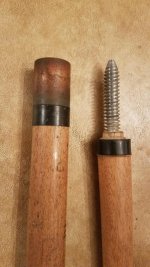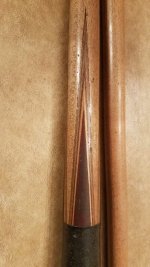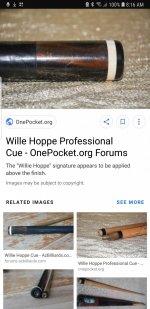You are using an out of date browser. It may not display this or other websites correctly.
You should upgrade or use an alternative browser.
You should upgrade or use an alternative browser.
Need help identifying an old cue.
- Thread starter madhatter44
- Start date
It looks to me to be an old Brunswick Professional. It could also be a Rambow cue that used a Brunswick blank.
The veneer colors or lack of colors and the ivory Hoppe ring on the bottom help date the cue.
I believe the pin has decided to stay in the shaft, maybe the glue has given up but normally it would be in the butt end.
The pin also looks to be steel and all of the cues I have seen were brass so that leads me to wonder if the pin has been replaced at one time and whomever did the work placed it in the shaft as a fix?
Neat old cue for sure.
The veneer colors or lack of colors and the ivory Hoppe ring on the bottom help date the cue.
I believe the pin has decided to stay in the shaft, maybe the glue has given up but normally it would be in the butt end.
The pin also looks to be steel and all of the cues I have seen were brass so that leads me to wonder if the pin has been replaced at one time and whomever did the work placed it in the shaft as a fix?
Neat old cue for sure.
Last edited:
Still looking for info..Thanks to those who already replied.
Thats a new screw. Somebody altered this cue. Does look like an old Bruns. Pro.: https://forums.azbilliards.com/showthread.php?t=374794 The joint on yours looks kinda funky due to that screw.
I agree it is most likely a Brunswick, or made from a Brunswick.
But a WH Pro? With no markings?
As far as pin stuck in shaft, I have seen at least two what were "fixed" after it was claimed the pin was stuck in the shaft. Neither of those cues had an insert in the shaft, so the pin was meant to be in the shaft originally.
Show us a better view of the pin end of that shaft. If there is an insert, I agree, the pin got stuck in the shaft. If there is no insert, then it was intentionally installed in that shaft.
Again, those look like non-dyed veneers to me, making this an earlier cue. That pin might belong in the shaft.
I don't know that, but I am open to it. I am not going to claim to be certain either way. I want to see the end of the shaft.
The end of that pin does look more modern to me...but I don't know for certain. Brunswick certainly did use steel pins though. And they certainly put them in the shaft.
The Titlist and Pro were introduced in 1941. This cue has no markings that we know of. Not even weight stamps.
Right now, if I had to guess, this is not a WH Pro. It is earlier, but just earlier. I had said maybe 1938. Just a guess.
It could also be a custom.
If there is an insert in the shaft, then the pin is stuck. If not, then it was installed in the shaft.
.
But a WH Pro? With no markings?
As far as pin stuck in shaft, I have seen at least two what were "fixed" after it was claimed the pin was stuck in the shaft. Neither of those cues had an insert in the shaft, so the pin was meant to be in the shaft originally.
Show us a better view of the pin end of that shaft. If there is an insert, I agree, the pin got stuck in the shaft. If there is no insert, then it was intentionally installed in that shaft.
Again, those look like non-dyed veneers to me, making this an earlier cue. That pin might belong in the shaft.
I don't know that, but I am open to it. I am not going to claim to be certain either way. I want to see the end of the shaft.
The end of that pin does look more modern to me...but I don't know for certain. Brunswick certainly did use steel pins though. And they certainly put them in the shaft.
The Titlist and Pro were introduced in 1941. This cue has no markings that we know of. Not even weight stamps.
Right now, if I had to guess, this is not a WH Pro. It is earlier, but just earlier. I had said maybe 1938. Just a guess.
It could also be a custom.
If there is an insert in the shaft, then the pin is stuck. If not, then it was installed in the shaft.
.
Still looking for info..Thanks to those who already replied.
I'm interested as hell to know more about how and where you came across the cue?
Please tell.
If the black collars on the butt and shaft are the same height, would what appears to be a wood insert protrude?I'm interested as hell to know more about how and where you came across the cue?
Please tell.
It also looks 3-tiered, which is kind of strange.
This is a Willie Hoppe Professional butt where the pin was yanked out. The shaft is from an older cue. Someone grafted an antique shaft onto a 40s butt.
The cue was obviously sanded or otherwise worked on, but this is a two-piece Brunswick cue, the pin came out of the butt. The brass joint says Hoppe.
The cue was obviously sanded or otherwise worked on, but this is a two-piece Brunswick cue, the pin came out of the butt. The brass joint says Hoppe.
Last edited:
This is a Willie Hoppe Professional butt where the pin was yanked out. The shaft is from an older cue. Someone grafted an antique shaft onto a 40s butt.
The cue was obviously sanded or otherwise worked on, but this is a two-piece Brunswick cue, the pin came out of the butt. The brass joint says Hoppe.
Definitely could be so.
That shaft does not look like it goes to that cue.
The black ring has been forced down further onto the tenon, likely from use. It did not correctly fit that joint.
It does look like an older shaft that got screwed onto a Hoppe Pro.
Last edited:
The old Brunswicks with the pins in the shaft didn't have big ole brass joints like that.
Cuemakers sand the signatures off all the time, not hard to do.
I could even do it
Definitely could be so.
Close examination and dimensions would determine if the cue had been sanded or turned to remove markings.
With the cue that dirty whatever was don it was a long time ago unless someone went to the trouble to fake a patina.
I just can't claim to definitively know from these pictures. It has both familiar features and unfamiliar features. To get it to the current state using the known stuff requires a good bit of assumptions about the work that was done.
All of those assumptions are reasonable.
.
With the cue that dirty whatever was don it was a long time ago unless someone went to the trouble to fake a patina.
I just can't claim to definitively know from these pictures. It has both familiar features and unfamiliar features. To get it to the current state using the known stuff requires a good bit of assumptions about the work that was done.
All of those assumptions are reasonable.
.
Dimensions are all over the board on those things.
They aren't Balabushka's
Yes, I know.
But variations in the dimensions or the cue not being round where stampings or markings would have been can show their removal. Of course alternatively, the entire cue could have been turned...which would leave it obviously skinny for the time period.
By no means do I mean that the dimensions of those cues are standardized, known, or consistent.
I just think that closer inspection could reveal the things we are looking for.
But if not...it would leave me to wonder...
.



